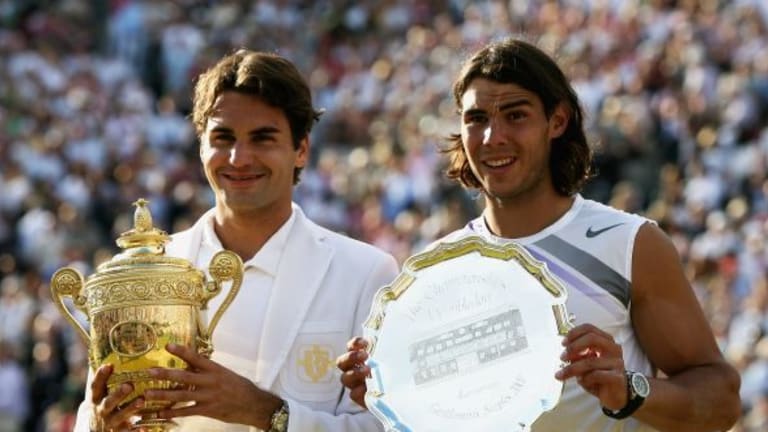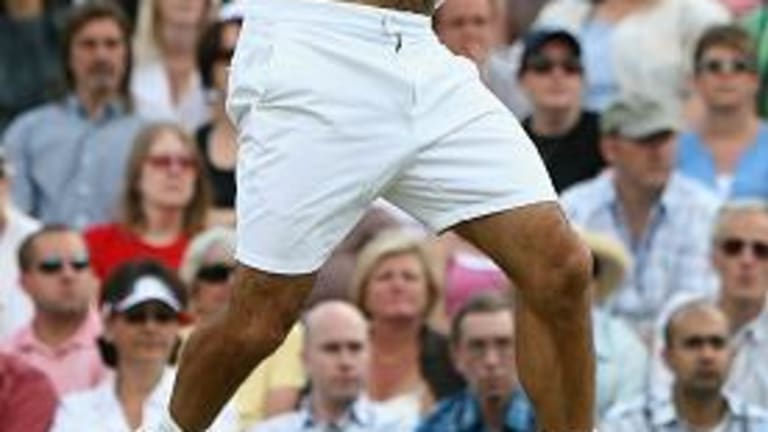The greatest bulls of all are the Spanish bulls, and among the Spanish bulls the greatest bulls are Miura bulls, which are bred in Sevilla, and among the Miura bulls, the greatest bull of all was Islero. It was Islero who killed the adored matadors, Monolete and Esparto, Islero's ferocity that led the bullfighters of Spain to sign a petition declaring that they no longer wished to fight Miura bulls, because Miura bulls had killed Manolete and Esparto, and they were the most savage and fierce bulls of all.
The great Curro Romero, Spain's leading matador, has never fought a Miura bull and says he never will, and Romero, a matador of surpassing elegance and deftness, is generally considered the bullfighter's version of Roger Federer.
This comparison is clearly qualified, because Federer faces the Miura bull - his very own Islero - on a regular basis these days, and he did so again yesterday. In an exceptional Wimbledon final today, Federer got the best of Rafael Nadal, who has the same blunt determination and bellicose urges as a Miura bull, and he has one thing that Islero never did, a human mind and heart, and that in a way makes him an even more formidable foe.
Yet once again on Wimbledon's lawn, Federer flourished his racquet with the elan of a matador and continually sidestepped the bull. Islero, in case you don't know, means "Islander", and Nadal himself, a native of Majorca, is a man of the islands. It didn't help. It was a day on which the matador prevailed. His Islero, I'm glad to report, is alive and doing well, albeit bruised up and, for now, chastened.
Federer won his fifth consecutive Wimbledon title, 6-2 in the fifth, to equal the record of Bjorn Borg. But this was the first time he had to go five sets to accomplish it, and by the time he was done his red cape was torn to ribbons and his white leggings were in tatters (actually, he put his long white trousers on backwards while awaiting the awards ceremony, which explains why he kept tugging at the waistband while he was allowing the photographers of the world to snap his picture with the trophy). It was that kind of match: gut-wrenching and brutal, pitting the sublime against the earthy under the umbrella of human convention, leaving no bloody sword on the field nor any terrible death rattle reverberating on the still air before a hushed crowd.
I thought Federer's serve won him the match, and this how it ought to be in grass court tennis. And this is how it was, despite the fact that Nadal did not lose his serve for 22 straight service games, until the sixth game of the fifth set. At that point, Federer played a few stunning forehands that penetrated Nadal like sharp steel. In the very next game, Federer produced three aces to hold at love, in effect sweeping his cape one last time before he administered the killing thrust. In his presser after the match, a subdued but philosophical Nadal admitted:
Those two escapes by Federer from 15-40 down bear noting: in the third game, Federer elicted two errors from Nadal, a service return and an errant forehand. Then, in the fifth game, Federer stepped aside from the horns with a serve that produced a botched return and an unreturnable serve. So he served his way out of danger on three of four occasions, and it was the fourth shot that Nadal himself cited as the key one.
When I asked The Mighty Fed if he was happy with the way he served on the big points, he replied:
That "for some reason" is in some ways the most telling part of that comment, because it seemed pretty clear that against Federer's superb serving, you had Nadal's superb groundwork. Most of the rallies that went to six or seven shots and more ultimately went to Nadal. And with TMF's net attacks producing mixed results (Federer won 8 of 14 serve and volley approaches, and 28 of 48 approaches from the baseline, neither representing a 60 per cent or better winning percentage), it really did come down to this: Could Federer take care of his serve and, despite conceding Nadal the ground game, put together enough good groundstrokes, at the right times, to break Nadal?
Federer did just that in that key sixth game of the final set; from 0-15, he struck a blazing forehand pass and another delicious forehand winner to pin down Nadal and score his first break since early in the first set. Federer's serve also featured as the major factor in the two tiebreakers that he won - 'breakers that always kept him ahead in the match score and helped keep him from spinning out of control on a day when he felt the scrutiny of the game, past and present, boring through the back of his shirt. He mentioned their names and conceded that he felt their eyes cast in judgement: Borg, John McEnroe, Jimmy Connors, Boris Becker. . . As he said: "Yeah, I mean it's special when the greats come around and watch you."
And don't for the moment think that Federer didn't feel some pressure in that regard, but pressure is a garment that fits Federer even better than that retro white dinner jacket he's been sporting. And this is a quality not to be dismissed. During the French Open, and at times in the match today, TMF has seemed a careworn man, a man whose only escape from the pressure is a slow, meditation on his strings, or the modest outlet afforded by a brief tiff with the chair umpire over Hawkeye. After Hawkeye robbed him of an apparent set point, Federer asked umpire Carlos Ramos to turn the danged thing off, and it seemed for a moment like he actually meant it to be taken seriously.
Once again, Federer spent portions of the match wandering around like an absent-minded man wondering where he had left those danged car keys. But while it seemed at Roland Garros that he was simply flustered and retreating into himself, that he did the same thing here amended the message he broadcast. The truth of it may be that Federer just needs to go someplace else for a while, stepping back for exactly the same reason that Nadal, in a comparable situation, lowers his head and advances, swinging his horns.

